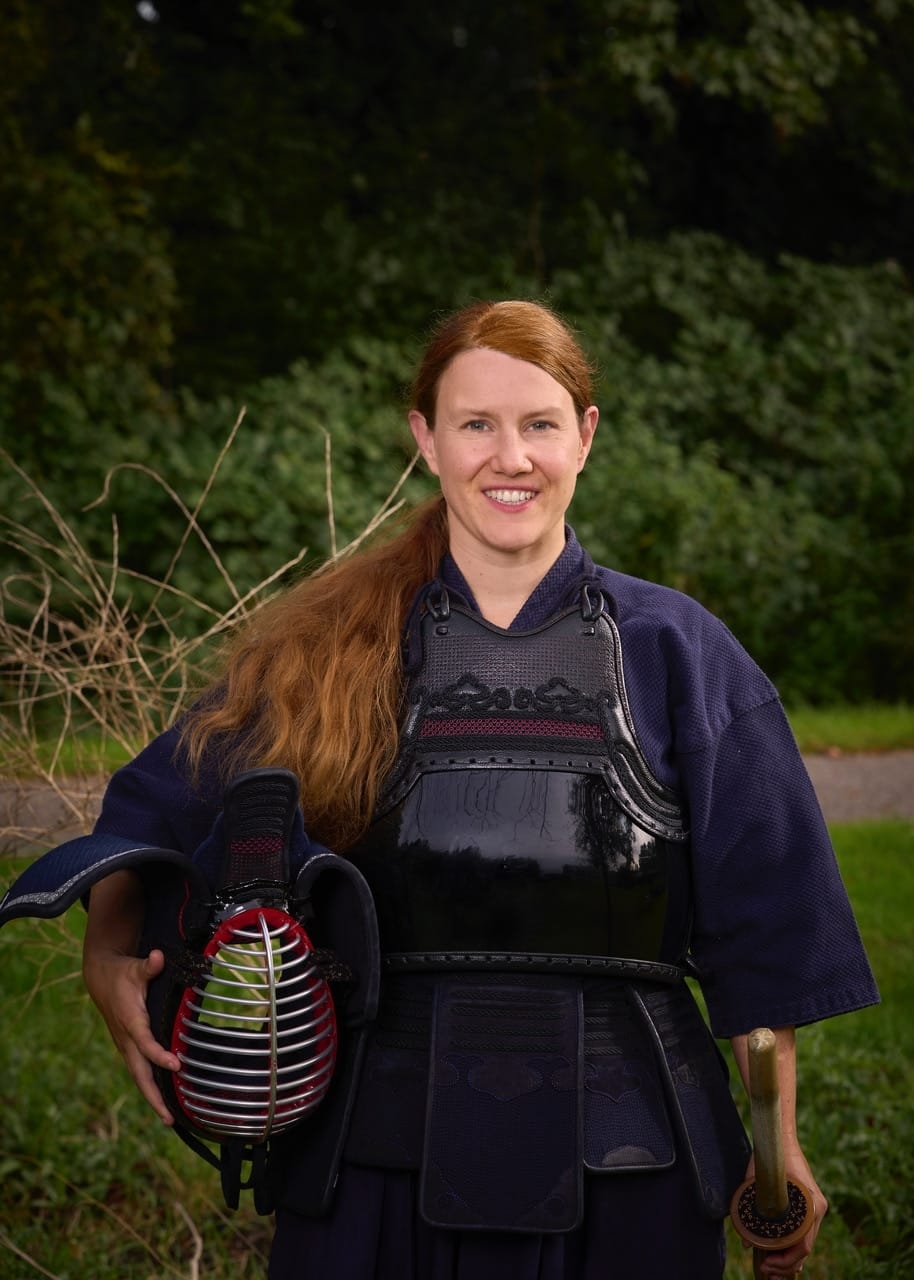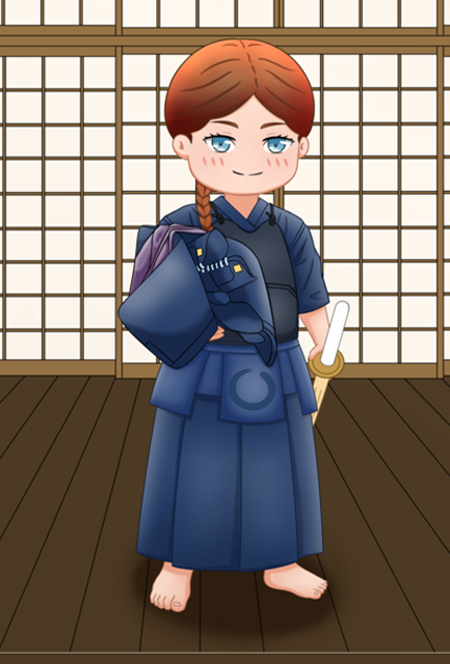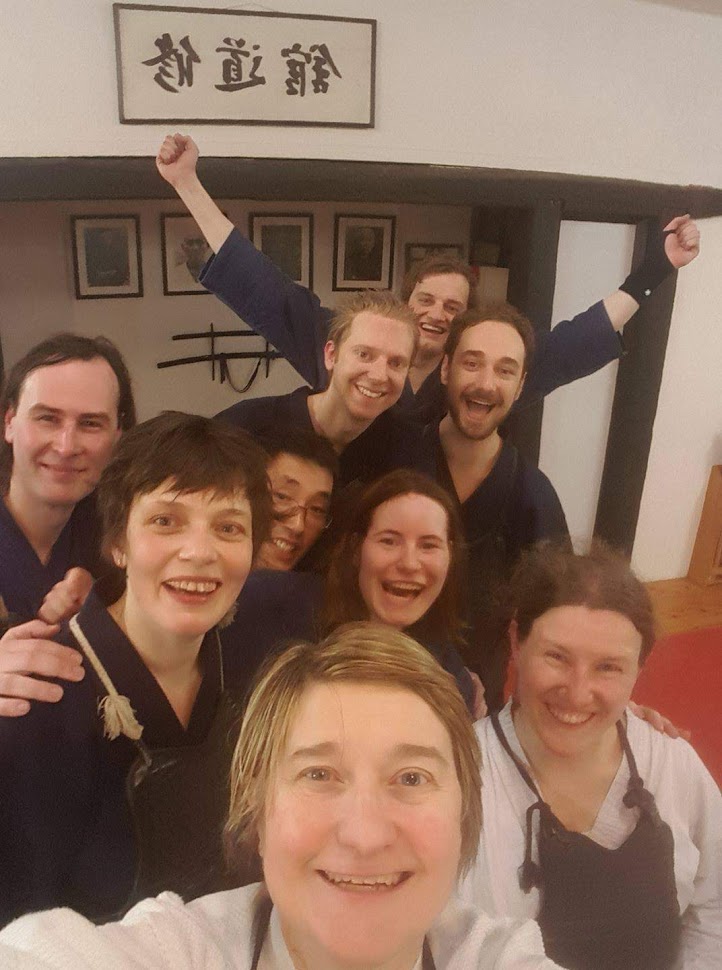The Way of the Sword as a Way to Connect: An Essay on Kendo and Autism

I am very honoured that – with an essay on kendo and autism – I could contribute to the website of a scholar that I admire. Thank you so much, Kate Sylvester!
[Photo above by René Bouwman for De Telegraaf]
The Way of the Sword as a Way to Connect: An Essay on Kendo and Autism
This essay is a form of autiethnography, a writing on the autistic Self, by the autistic Self. As I can only speak for my-Self, I feel that I should start with a little disclaimer. The following account is solely my perspective, based on my personal experiences as an autistic female budoka in the Netherlands. Kendo has brought me a tremendous amount of benefits, but that does not mean that it is good for all people with autism. One thing that ‘neurotypical’ (non-autistic) people may not know about autism, is that it is a spectrum, meaning that the characteristics and expressions can vary widely from person to person. While some individuals with autism may have difficulties with social interactions and communication (especially with non-autistic peers), others may excel in these areas but struggle with sensory processing or harmful repetitive behaviours. Additionally, it’s important to note that autism often co-occurs with anxieties that complicate daily life, including kendo practice. Overall, this is only my voice, and understanding the diverse range of experiences and needs of individuals with autism is crucial in promoting inclusion and support for the autistic community in the dojo.
Social Challenges
“Is our dojo the building or the group?”- I once asked my sensei, for it was very vague to me whether dojo rules also apply in the building’s dressing room and in the hallway and when training is over, and whether they also apply in the dojo’s chat group and/or at the dojo’s parties etc. etc. etc. In general, neurodiverse individuals often struggle with so-called ‘soft skills’, especially ones that apply to neurotypical social interactions and unwritten rules, and I am no exception to that. My attempts to help the dojo improve can easily be perceived as pedantic or a nuisance. It’s important to recognize that individuals with autism, like all individuals, have unique personalities and desires, and may have varying levels of comfort and skill in social situations. Open and honest communication both ways is the only way forward, and by now I have pleasant agreements with my sensei and senpai on how to help – and also: on what doesn’t help. In my case: I am responsible for keeping our equipment locker tidy and I am responsible for managing our ‘box of sweets’, a bag full of Japanese delicacies that we bring to training sessions and competitions. Things that don’t help are my ‘puzzles’ in our app group (puns in other languages, like spelling 主⼈ as 囚⼈ , and rebuses, such as a cookie-, a heart- and a wave-emoticon for another ryuha – these are better suited for one-to-one contact with the people who can laugh about them) and interrupting class to ask for details that are not specific to the exercise in question (only ask something if you cannot do the exercise or if you think it is dangerous, you can always ask sensei for more details after class). Due to the efforts of our dojo leaders, the dojo is now a safe place for me, where I can be myself (within limits). But this has not always been the case; until a little over a year ago, I was too scared and nervous to attend training because a senpai had been mean to me. While I will never know for sure what the role of my autism was in this particular instance (I was not exactly the only one troubled by this senpai’s behaviour), I think it is important to mention this, as to raise awareness for the fact that people with autism are always more at risk of being excluded and bullied – even in dojo contexts.
Physical Challenges
Besides these social challenges, I also experienced physical obstacles. For people with autism, participating in kendo can be challenging due to the high levels of stimulation and muscle tension involved in the activity. Firstly, people with autism may be sensitive to sensory stimulation, a ‘porosity’ which can make it difficult to tolerate the loud shouting and noise that is often associated with kendo. Additionally, the feeling of the protective gear and the physical contact with another person can be overwhelming and cause anxiety or discomfort. Secondly, people with autism may experience high levels of muscle tension or difficulties with motor coordination, which can make it difficult to perform the precise movements required in kendo. Kendo requires a great deal of focus and control over one’s body, which can be challenging for individuals who struggle with motor planning and coordination. On the flip side, this is exactly why it could be so beneficial for people with autism to practise kendo, as it immensely trains your body control, balance and coordination, as well as reaction speed. With the help of my sensei and senpai, I was able to overcome my personal challenges with adjustments to my clothing (such as special leggings under my hakama), by wearing earplugs and by taking enough breaks at seminars, but I fully realise that this may not be as easy to solve for other people with autism.
Special Interest
Soon, I started liking kendo so much that it soon became one of my autistic ‘special interests’. These preoccupations are different from ‘ordinary’ hobbies because we are involved in them much more intensely. Rather than a matter of rational choice and focus, an autistic special interest seems more like a way of life and being. For people with autism, special interests are often good for their mental health and well-being, as they provide an outlet, a ‘flow’ in which they can find peace and grip and recharge after overstimulation. In addition, they are simply a very enjoyable leisure activity! Yet there also lurks a risk in autistic special interests, which is that you might get carried away in them. An autistic person can thus go on with a certain activity for too long, doing violence to their body (hair loss due to endless dyeing or crafting to the point of bleeding fingers, for example). This also happened to me in the case of kendo. I trained at home, signed up for iaido as well, and went to the gym every day. That may seem positive, but I went from zero to 100 in one go – with my increased muscle tension. Being on the treadmill for hours on end caused me to tear my Achilles tendons. Not being in good touch with my body, I thought it was muscle pain and continued with my self-imposed schedule, which also caused the tendons to inflame. On the morning after my first Dan exam, I got up and could no longer walk. Long story short: no more kendo for me. That is, no regular training in the dojo. But fortunately, in the meantime, many other ways had emerged for me to engage with kendo and the kendo community.
In the COVID lockdown, of course, everything came to a halt at once. I missed my budo mates, and from that void two kendo-related projects emerged. The first – Budoka in times of COVID – is a research project exploring how we practised during the lockdown. It is set up as a ‘mixed methods’ combination of qualitative and quantitative research. The research is thus not only to, for and for the benefit of martial arts, but also in and through martial arts itself. Building further on my autiethnographies “On my Way” and “The Do less Travelled By”, I invited others to reflect on their do as well. In my opinion, budo and artistic research are both ways of living that have surprisingly much in common. Both force you to be critical towards yourself, to shape your character and artistic identity by examining your desires as well as your fears. Both help you to become a better person. And both can assist you in making contact with peers (from various neurotypes). The results will be processed into an academic article and submitted to a scientific journal for publication. In addition, this research serves a practical purpose: by sharing the results through more accessible publications, both individual budoka and dojo will be able to learn from each other. This way, budoka will have more tools during a similar period in the future and hopefully be better prepared.
The second and largest kendo-related project to emerge in the lockdown is Japan Fans. It started as a personal WhatsApp group of dojo friends to exchange interesting facts about Japan, but quickly got out of hand. By now, we have more than 3700 members, an official foundation with subsidies and sponsors, we organise two or three Japan-related events per week, and we are exploring locations to establish a Japanese Cultural Center in Utrecht. Thanks to Japan Fans, I have given many concerts and demonstrations at large events, and exhibited my art and artistic research in many beautiful spaces, such as the main hall of the central library and the city hall of Utrecht. The ball kept rolling. I helped organise the Leiden Seminar for Women in Kendo and Iaido, launched an illustrated brand called BudoGirl, and wrote essays and made illustrations for Zanshin (the bulletin of the Dutch kendo federation) and Kendo Jidai. I think that it’s safe to assume that, without kendo, I would never have gotten where I am now.

Image: BudoGirl kendogirl in de dojo
Reflections
As you might have guessed from the above account, even if I make it back to regular kendo trainings, I shall never be a brilliant competitive kendoka. But that doesn’t matter to me, as my goals have been different from the start. Above all, I just like to do fun things with friends, and kendo is a way for me to connect with people who like my special interest in Japanese martial arts. Moreover, the dojo is a safe place for me, where clear rules apply and my sensei and senpai take care of me.
With this short essay, I hope to have explained something about the benefits of kendo as a way to connect for people with autism. Unfortunately, it is a common misconception that people with autism have no desire for human contact and friendships. While individuals with autism may have difficulties with (neurotypical) social interactions and communications, this does not mean that they do not long for social contacts and relationships. In fact, many individuals with autism have a strong desire for connection, but may struggle with the neurotypically defined social skills necessary to form and maintain these relationships. People with autism may also have sensory sensitivities that can make social interactions uncomfortable or overwhelming, which can further complicate their ability to connect with others. And as soon as budo becomes a special interest, new pitfalls arise. But with support and understanding, individuals with autism can develop meaningful relationships and connections with others, and in this process a budo – like kendo – can make a world of difference.
I am very grateful to our dojo for including me – and for our dojo leaders (my iaido sensei) who sustain me – despite all the inconveniences, adjustments, my never ending stream of awkward questions and injuries and more… and I consider myself lucky to have been allowed to train kendo with two amazing sensei – Donatella Castelli sensei and Louis Vitalis sensei – that were absolutely wonderful to me, hugely supportive and enthusiastic. Thanks to all these people, I was able to experience kendo. The way of the sword taught me to be steadfast, to stick to my own course, on my own path. It put me in better touch with my body and held up a mirror to me when I was asking too much of it. Next to that, it deepened my way of artistic research. And last but not least, it brought me in contact with people who share my special interest in Japan, and with that, it helped me to connect.

Photo: Martine’s first time in bogu with Castelli sensei
Martine Mussies was first introduced to kendo at the Martial Arts Festival in her hometown Utrecht, and started practising at Yushinkan (with Louis Vitalis sensei) and at Sakura Kai (with Donatella Castelli sensei). On a training schedule of 11 hours of budo per week (seminars and competitions not included), Martine holds dan grades in various arts and has won prizes across disciplines internationally. Martine is the founder of Japan Fans, a foundation that strives towards establishing a Japanese Cultural Centre in Utrecht. She contributes to the international kendo community through writing, designing, organising… and baking extraordinary cake-o!
Leave a Reply